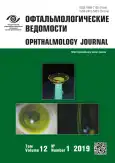Особенности формирования эпителиального слоя трансплантата роговицы
- Авторы: Милюдин Е.С.1, Кучук К.Е.2
-
Учреждения:
- ГБУЗ «Самарская областная клиническая офтальмологическая больница им. Т.И. Ерошевского»
- ФГБОУ ВО «Самарский государственный медицинский университет» Минздрава России
- Выпуск: Том 12, № 1 (2019)
- Страницы: 53-58
- Раздел: Офтальмофармакология
- URL: https://journals.rcsi.science/ov/article/view/11328
- DOI: https://doi.org/10.17816/OV2019153-58
- ID: 11328
Цитировать
Полный текст
Аннотация
Актуальность. Существенное влияние на выживаемость трансплантата оказывает задержка формирования эпителиального покрова.
Цель исследования — цитологическая характеристика и анализ влияния лекарственных препаратов на формирование эпителиального слоя на трансплантате.
Материалы и методы. Проанализировано послеоперационное состояние 20 пациентов, оперированных по поводу буллёзной кератопатии и язвы роговицы. Мазки-отпечатки с поверхности трансплантата окрашивали красителем «Лейкодиф 200» (LDF 200) и исследовали под световым микроскопом.
Результаты. Формирование эпителиального слоя во всех случаях завершилось не позднее 8–10-х суток после кератопластики. По результатам цитологического анализа был предложен комплекс послеоперационного лечения, включавший препарат Виксипин с 10-го дня послеоперационного периода. Улучшение зрения наступило у 11 больных (75 % случаев), оперированных по поводу буллёзной кератопатии, и четверых пациентов, оперированных по поводу язвы роговицы.
Выводы. Формирование эпителиального слоя на поверхности трансплантата роговицы происходит за счёт миграции зрелых эпителиальных клеток с краёв раны собственной роговицы и митотической активности лимбальных клеток реципиента. Длительно существующие эпителиальный дефект и воспаление, предшествующие кератопластике, приводят к замедлению процесса эпителизации трансплантата в послеоперационном периоде. Применение кортикостероидов, натрия гиалуроната и антиоксидантов в послеоперационном периоде способствует формированию полноценного эпителиального слоя.
Ключевые слова
Полный текст
Открыть статью на сайте журналаОб авторах
Евгений Сергеевич Милюдин
ГБУЗ «Самарская областная клиническая офтальмологическая больница им. Т.И. Ерошевского»
Автор, ответственный за переписку.
Email: miljudin@mail.ru
ORCID iD: 0000-0001-7610-7523
SPIN-код: 2034-2910
Scopus Author ID: 7801402280
MD, Ophthalmologist, Head of Ophthalmology Department
Россия, СамараКсения Евгеньевна Кучук
ФГБОУ ВО «Самарский государственный медицинский университет» Минздрава России
Email: kuchukke@rambler.ru
SPIN-код: 7785-4779
врач-офтальмолог
Россия, СамараСписок литературы
- Слонимский А.Ю., Слонимский Ю.Б., Долгий С.С. Сквозная пересадка роговицы при гнойных процессах переднего отрезка глазного яблока // РМЖ. Клиническая офтальмология. – 2010. – Т. 11. – № 1. – С. 11–14. [Slonimskii AY, Slonimskii YB, Dolgii SS. Penetrating keratoplasty in patients with purulent processes of anterior eye segment. RMZh. Klinicheskaya oftalmologiya. 2010;11(1):11-14. (In Russ.)]
- Злобин И.А., Черныш В.Ф., Чурашов С.В., и др. Роль импрессионной цитологии в оценке фенотипа эпителия роговицы при решении вопроса о показаниях к операции оптической кератопластики // Вестник Российской военно-медицинской академии. – 2016. – № 1. – С. 89–93. [Zlobin IA, Chernysh VF, Churashov SV, et al. Role of impression cytology in cornea epithelium phenotype assessment at solution of question of indications to operation of optical keratoplasty. Vestnik Rossiiskoi voenno-meditsinskoi akademii. 2016;1:89-93. (In Russ.)]
- Милюдин Е.С., Золотарёв А.В., Милюдин А.Е. Возможности местной иммуносупрессии при повторной кератопластике // РМЖ. Клиническая офтальмология. – 2014. – Т. 14. – № 3. – С. 1–5. [Milyudin ES, Zolotarev AV, Milyudin AE. Possibilities of local immunosuppression in repeated keratoplasty. RMZh. Klinicheskaya oftalmologiya. 2014;14(3):1-5. (In Russ.)]
- Тонаева Х.Д., Онищенко Н.А., Борзенок С.А. Лимбальная трансплантация как способ индукции локальной иммунной толерантности при кератопластике высокого риска // Вестник трансплантологии и искусственных органов. – 2011. – Т. 13. – № 2. – С. 95–102. [Tonaeva KD, Onishchenko NA, Borzenok SA. Limbal transplantation as a method of local immune tolerance induction in high risk keratoplasty. Russian Journal of Transplantology and Artificial Organs. 2011;13(2):95-102. (In Russ.)]. https://doi.org/10.15825/1995-1191-2011-2-95-102.
- Feiz V, Mannis MJ, Kandavel G, et al. Surface keratopathy after penetrating keratoplasty. Trans Am Ophthalmol Soc. 2001;99:159-168.
- Tsubota K, Mashima Y, Murata H, et al. Corneal epithelium following penetrating keratoplasty. Br J Ophthalmol. 1995;79(3):257-260. https://doi.org/10.1136/bjo.79.3.257.
- Raj A, Dhasmana R, Bahadur H. Factors associated with surface epithelial keratopathy after optical penetrating keratoplasty. J Curr Ophthalmol. 2017;29(2):108-115. https://doi.org/10.1016/j.joco.2017.01.002.
- Борзенок С.А. Медико-технологические и методологические основы эффективной деятельности глазных тканевых банков России в обеспечении операций по сквозной трансплантации роговицы: Дис. … д-ра мед. наук. – М., 2008. – С. 240–259. [Borzenok SA. Mediko-tekhnologicheskiye i metodologicheskiye osnovy razvitiya deyatel’nosti glaznykh tkanevykh bankov Rossii v obespechenii operatsiy po skvoznoy transplantatsii rogovitsy. [dissertation] Moscow; 2008. P. 240-259. (In Russ.)]
- Труфанов С.В., Маложен С.А., Полунина Е.Г., и др. Синдром рецидивирующей эрозии роговицы (обзор) // Офтальмология. – 2015. – Т. 12. – № 2. – С. 4–12. [Trufanov SV, Malozhen SA, Polunina EG, et al. Recurrent corneal erosion syndrome (a review). Ophthalmology in Russia. 2015;12(2):4-12. (In Russ.)]. https://doi.org/10.18008/1816-5095-2015-2-4-12.
- Garrana RM, Zieske JD, Assouline M, Gipson IK. Matrix metalloproteinases in epithelia from human recurrent corneal erosion. Invest Ophthalmol Vis Sci. 1999;40(6):1266-1270.
- Feiz V, Mannis MJ, Kandavel G, et al. Surface keratopathy after penetrating keratoplasty. Trans Am Ophthalmol Soc. 2001;99:159-168.
- Smolin G. Suppression of the Corneal Homograft Reaction by Antilymphocyte Serum. Arch Ophthalmol. 1969;81(4):571-576. https://doi.org/10.1001/archopht.1969.00990010573020.
- Vannas A, Holden BA, Sweeney DF. Epithelial metabolism of the corneal graft is abnormal. Br J Ophthalmol. 1987;71(8):593-597. https://doi.org/10.1136/bjo.71.8.593.
Дополнительные файлы












